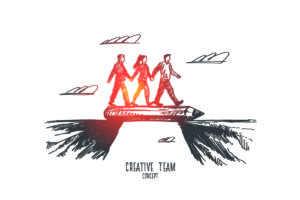Boundaries exist for good reasons. They protect us from what we perceive as a threat to our way of doing things, worldview or environment. Without boundaries, we feel vulnerable – threats to our shared structures, routines, rituals, stories, control systems and symbols seem more real.
Unfortunately, or fortunately, increasingly, it’s becoming necessary to ‘break through boundaries’ to accommodate diversity if we’re serious about fostering synergy. However, breaking boundaries isn’t always a smooth process — we tend to resist what we perceive as a threat.
Breaking boundaries mean cultural reforms — a change process that’s slow but painful. It’s not an easy transition. In fact, the strength of resistance can increase if the change process doesn’t align with prevailing culture, and more so if change’s radical.
And because culture is linked to organizational success, performance and strategic vision, change’s delicate process that should be handled with lots of care. Otherwise, counterproductive outcomes would occur – staff turnover, low morale, dissatisfaction, conflicts, egocentric tendencies, bureaucracy, reduction in organization’s bottom line, etc.
However, boundaries limit us and our relationship with others. Breaking boundaries doesn’t always work out but flexing works better. It’s more viable for diverse forces to interact within a flexible boundary.
Manifestations of Boundaries and Diversity in Organizations
Interactions occur at the boundary. And the rigidity of that boundary depends on the extent to which those within it perceive those outside as different. Similar reality applies to organizations. Boundaries arise when an organization, department, individual or unit sets objectives, which differ markedly between the organizational elements.
Boundaries and diversity in the following areas other than objectives:
- Expertise and Experience
Employees differ in their skills, abilities and experiences. As a result, employees specialize in different areas — expertise levels differ significantly. Furthermore, factors such as age, number of years worked, and exposure to different organizations determine experience.
- Authority and Responsibility
In an organization, just as in a society, there are roles and responsibilities. These depend on one’s status or hierarchy. The higher one’s level’s in a hierarchy, the more the power and responsibility.
- Hierarchical Structure
It’s usual for organizations to have a top-down structure — a pyramid in which the senior managers or executives are the top and subordinates at the bottom. Hierarchy influences how workers at various levels interact with each other. A top-down hierarchy is a great obstacle to assimilating the language of synergy, because it’s difficult for people of different statues to work mutually in one place. As they say, “birds of a feather flock together”.
- Organizational Culture
Global organizations have both local and global culture, because they operate in different countries or markets across the globe. Even within organizations, there are sub-cultures – working culture may differ between field and office employees or between various departments. Sub-cultures can range from flexibility in creative thinking by the R&D department to adherence to timetables by the production department.
- Physical and Territorial Boundaries
Organizations, which operate abroad, and have headquarters at home, are global, multinational corporations. And because they operate between different countries, which have different territorial boundaries, so are the branches of the same organization themselves. For instance, outsourcing of manufacturing department abroad, franchising, etc.
However, the organization’s core activities remain at home — all activities don’t take place under same roof; hence, physical boundary. Rigid physical boundaries make it difficult for headquarters to function properly.
Ego – The Main Culprit Behind Organizational Boundaries and Diversity
Ego, depending on its strength, influences the rigidity of the boundaries. The stronger ego, the more rigid a boundary becomes. With greater rigidity, synergy becomes difficult to attain. The more flexible a boundary is, the easier it’s to foster a synergistic and cooperative mind-set.
And because it’s possible to foster synergy and cooperation within flexible boundaries, it’s important that those within the boundary feel safe in engaging in synergistic interactions. The greater the quality of communication – clear and timely – the safer and more comfortable one would feel cooperating with a culturally different person.
And the higher the quality of communication, the lesser the tendency toward egocentric behaviors. Fear, personality, ambition, wish and need can inflate one’s ego; in fact, so much so that boundaries between one and another become rigid. This can foil efforts to foster synergy and cooperation.
Other culprits behind boundaries and diversity include:
- Lack of confidence
- Rigidity
- Other personality traits
- Internalization levels
- Problems with adaptation to change and abandonment of comfort zone
The Bottom Line…
Resistance to change; hence, resistance to synergy and cooperation, can get increase if factors such as ambition, need, wish, fear and personality contribute to the exaggeration of one’s ego. The greater the ego, the more rigid the boundary becomes. While ego is the main suspect behind opposition to synergy, other factors play role, too. Lack of confidence, internalization levels, difficulties in adapting to change and leaving comfort zone, personality and rigidity can make one more resistant to synergy and cooperation.




Hope
7 Sep 2018Wow that was odd. I juet wrote ann xtremely long comment but after I clicked submit my comment
didn’t show up. Grrrr… well I’m not writing all tha overr again. Anyhow,
just wanted to say excellent blog!
Rapid Results Keto
8 Sep 2018There’s certainly a lot to know about this subject.
I love all of the points you’ve made.